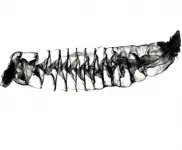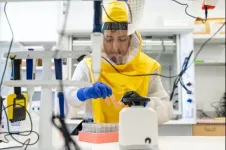(Press-News.org) Contrary to what popular media portrays, we actually don't know much about what sharks eat. Even less is known about how they digest their food, and the role they play in the larger ocean ecosystem.
For more than a century, researchers have relied on flat sketches of sharks' digestive systems to discern how they function -- and how what they eat and excrete impacts other species in the ocean. Now, researchers have produced a series of high-resolution, 3D scans of intestines from nearly three dozen shark species that will advance the understanding of how sharks eat and digest their food.
"It's high time that some modern technology was used to look at these really amazing spiral intestines of sharks," said lead author Samantha Leigh, assistant professor at California State University Dominguez Hills. "We developed a new method to digitally scan these tissues and now can look at the soft tissues in such great detail without having to slice into them."
The research team from California State University Dominguez Hills, the University of Washington and University of California, Irvine, published its findings July 21 in the journal Proceedings of the Royal Society B.
The researchers primarily used a computerized tomography (CT) scanner at the UW's Friday Harbor Laboratories to create 3D images of shark intestines, which came from specimens preserved at the Natural History Museum of Los Angeles. The machine works like a standard CT scanner used in hospitals: A series of X-ray images is taken from different angles, then combined using computer processing to create three-dimensional images. This allows researchers to see the complexities of a shark intestine without having to dissect or disturb it.
"CT scanning is one of the only ways to understand the shape of shark intestines in three dimensions," said co-author Adam Summers, a professor based at UW Friday Harbor Labs who has led a worldwide effort to scan the skeletons of fishes and other vertebrate animals. "Intestines are so complex -- with so many overlapping layers, that dissection destroys the context and connectivity of the tissue. It would be like trying to understand what was reported in a newspaper by taking scissors to a rolled-up copy. The story just won't hang together."
From their scans, the researchers discovered several new aspects about how shark intestines function. It appears these spiral-shaped organs slow the movement of food and direct it downward through the gut, relying on gravity in addition to peristalsis, the rhythmic contraction of the gut's smooth muscle. Its function resembles the one-way valve designed by Nikola Tesla more than a century ago that allows fluid to flow in one direction, without backflow or assistance from any moving parts.
This finding could shed new light on how sharks eat and process their food. Most sharks usually go days or even weeks between eating large meals, so they rely on being able to hold food in their system and absorb as many nutrients as possible, Leigh explained. The slowed movement of food through their gut caused by the spiral intestine probably allows sharks to retain their food longer, and they also use less energy processing that food.
Because sharks are top predators in the ocean and also eat a lot of different things -- invertebrates, fish, mammals and even seagrass -- they naturally control the biodiversity of many species, the researchers said. Knowing how sharks process what they eat, and how they excrete waste, is important for understanding the larger ecosystem.
"The vast majority of shark species, and the majority of their physiology, are completely unknown. Every single natural history observation, internal visualization and anatomical investigation shows us things we could not have guessed at," Summers said. "We need to look harder at sharks and, in particular, we need to look harder at parts other than the jaws, and the species that don't interact with people."
The authors plan to use a 3D printer to create models of several different shark intestines to test how materials move through the structures in real time. They also hope to collaborate with engineers to use shark intestines as inspiration for industrial applications such as wastewater treatment or filtering microplastics out of the water column.
INFORMATION:
Other co-authors on the paper are Donovan German of University of California, Irvine, and Sarah Hoffmann of Applied Biological Services.
This research was funded by Friday Harbor Laboratories, the UC Irvine OCEANS Graduate Research Fellowship, the Newkirk Center Graduate Research Fellowship, the National Science Foundation Graduate Research Fellowship Program and UC Irvine.
For more information, contact Leigh at sleigh@csudh.edu and Summers at fishguy@uw.edu.
Images available for download: https://drive.google.com/drive/folders/1te8DfhcY9XwvoabSFdU5JChFrk1SQLsf?usp=sharing
Being more physically active and spending fewer hours per day sitting watching TV is linked to a substantially lower risk of developing obstructive sleep apnoea (OSA), according to new research published in the European Respiratory Journal [1]. It is the first study to simultaneously evaluate physical activity and sedentary behaviour in relation to OSA risk.
OSA is a condition where breathing stops and starts many times during sleep. It reduces oxygen levels in the blood and common symptoms include snoring, disrupted sleep and feeling excessively tired. ...
Study offers first global estimates of the number of children who experienced the death of a parent, grandparent, or primary caregiver from COVID-19.
Researchers estimated figures based on COVID-19 mortality data from March 2020 through April 2021, and national fertility statistics for 21 countries, and extrapolated findings to produce global estimates.
Findings suggest 1 million children have lost a parent, 1.1 million have lost a parent or custodial grandparent, and more than 1.5 million have lost a parent, custodial grandparent, or other secondary familial caregiver from COVID-19.
Authors call for urgent investments in services to support children who have lost their parents and caregivers.
An estimated ...
New research published in Anaesthesia (a journal of the Association of Anaesthetists) by researchers from the University of Bristol can help to improve the efficiency of surgery and help tackle the growing backlog of surgery caused by the COVID-19 pandemic. During the pandemic, the number of patients waiting for routine surgery in the UK has almost doubled with more than 5.3 million people awaiting surgery including more than 300,000 waiting more than a year.
A contributory factor is that COVID-19 precautions have led to many operating theatres working at 75-50% of normal working efficiency. Staff working in operating theatres have been required to take special precautions at the start and end of operations to allow viral particles ...
More than 1.5 million children around the world are estimated to have lost at least one parent, custodial grandparent, or grandparent who lived with them due to death related to COVID-19 during the first 14 months of the pandemic, according to a study published today in The Lancet. The study highlights orphanhood as an urgent and overlooked consequence of the pandemic and emphasizes that providing evidence-based psychosocial and economic support to children who have lost a caregiver must be a key part of responding to the pandemic.
The analysis used mortality and fertility data to model rates of COVID-19-associated orphanhood (death of one or both parents) and deaths of custodial and co-residing grandparents (ages 60-84) from March 1, 2020 to April 30, 2021, across 21 countries. This study ...
Metabolic bone diseases, including osteoporosis, when bones lose their mass and become so fragile that they could be damaged while sneezing or under little stress, are called the silent epidemic of the 21st century. A person does not even know about his illness before the first symptom - it can be a fracture of the spine or the neck of the hip. According to statistics, every third woman and every fifth man after 50 have osteoporosis. Thus, it is promising to search for and obtain substances and materials for implants that have osteoinductive properties and are capable of initiating the processes of transformation of stem cells into bone.
Certain trace elements, such as calcium and magnesium, influence the processes of bone regeneration ...
In the early days of the pandemic, scientists at Virginia Tech created a COVID-19 testing laboratory and novel test for the virus from scratch.
They not only developed a test in-house that avoided the reagent supply shortages that hampered testing efforts nationwide, but also used 3D-engineered supplies and stable storage media, enabling samples to be transported to rural sites in Virginia without the need for constant refrigeration.
This novel protocol for transforming a research laboratory into a testing operation capable of processing more than 130,000 ...
Spider silk is said to be one of the strongest, toughest materials on the Earth. Now engineers at Washington University in St. Louis have designed amyloid silk hybrid proteins and produced them in engineered bacteria. The resulting fibers are stronger and tougher than some natural spider silks.
Their research was published in the journal ACS Nano.
To be precise, the artificial silk -- dubbed "polymeric amyloid" fiber -- was not technically produced by researchers, but by bacteria that were genetically engineered in the lab of Fuzhong Zhang, a professor ...
ITHACA, N.Y. - Small-scale. Short-lived. All digital. Out of public view. That's how a new form of collective worker resistance is unfolding in China's app-based food delivery economy, new Cornell University research finds.
Though highly fragmented and not always successful, "mini-strikes" by small groups of food couriers - conducted via WeChat - reflect a new form of leverage, suggest Chuxuan "Victoria" Liu and Eli Friedman, associate professor in the ILR School.
Food couriers are able to maintain complete physical invisibility, and each individual worker can 'strike' from anywhere, they write.
The scholars interviewed couriers, in-person and online, who delivered food for Ele.me, an Alibaba-owned company that controlled ...
Tuesday, July 20, 2021, CLEVELAND: A Cleveland Clinic study demonstrates that adults with obesity lost significantly more weight when they had access to medications for chronic weight management in conjunction with their employer-based weight management program, compared to adults who did not have access to the medications. The study was published in JAMA Network Open.
Obesity is a complex disease that is caused by multiple factors, including genetic, environmental, and biological. A lifestyle intervention with a focus on nutrition and exercise is often not enough to treat obesity, which is a chronic disease that requires long-term therapy. The U.S. Food and Drug ...
WASHINGTON - A peer-reviewed study by the Environmental Working Group recommends stringent health-based exposure standards for both children and adults for radiofrequency radiation emitted from wireless devices. EWG's children's guideline is the first of its kind and fills a gap left by federal regulators.
The study, published in the journal Environmental Health, relies on the methodology developed by the Environmental Protection Agency to assess human health risks arising from toxic chemical exposures. EWG scientists have applied the same methods to radiofrequency radiation from wireless devices, ...


